
In his work, Paul Shambroon mostly focuses on American-specific subjects. As such, he took advantage of the end of the Cold War to access nuclear military zones in his country, considering his work a civic duty. Since September 11th 2001, this series has been interrupted due to forbidden access to those sites. Extracts of the series are now on show at the Red Cross and Crescent Museum in Geneva, representing commando sites that are used for the launching of nuclear missiles. His series Meeti [...]
In his work, Paul Shambroon mostly focuses on American-specific subjects. As such, he took advantage of the end of the Cold War to access nuclear military zones in his country, considering his work a civic duty. Since September 11th 2001, this series has been interrupted due to forbidden access to those sites. Extracts of the series are now on show at the Red Cross and Crescent Museum in Geneva, representing commando sites that are used for the launching of nuclear missiles. His series Meeting, which he has started working on in 2001, three photographs of which are shown in PANORAMIC SCENES, feeds on a similar concern for democracy in the United States. Whereas the first series sought transparency, Meeting is a rather bitter acknowledgement of the Americans’ lack of interest in local politics. The photographer attended local assemblies in villages of less than 2000 people to photograph the sitting local council. As Richard B. Woodward wrote about Shambroom’s photographs, “everything leads us to believe that the attendees were neither numerous, nor enthusiastic. The shameful secret of American political life does not lie within power relationships behind closed doors, but within the voters’ deep disinterest. Paul Shambroom praises unknown people who heroically take up responsibilities that we shy away from. Under the neon lights, their worn-out faces leaves no room for Franck Capra-style enthusiasm.